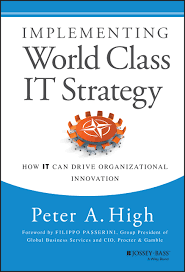In today's rapidly evolving digital landscape, a robust and forward-thinking IT strategy is no longer a mere supporting function; it has become a cornerstone for competitive advantage. This white paper explores the key elements of implementing a world-class IT strategy that aligns with business goals, drives innovation, and delivers tangible value.
Implementing World-Class IT Strategy: A Roadmap for Business Success
1. Introduction
In today's rapidly evolving digital landscape, a robust and forward-thinking IT strategy is no longer a mere supporting function; it has become a cornerstone for competitive advantage. This white paper explores the key elements of implementing a world-class IT strategy that aligns with business goals, drives innovation, and delivers tangible value.
2. Defining World-Class IT Strategy
A world-class IT strategy transcends traditional IT functions. It:
- Is Business-Driven: Deeply integrated with the organization's overall business strategy, supporting key objectives and contributing to business growth.
- Focuses on Innovation: Leverages technology to drive innovation, create new business models, and gain a competitive edge.
- Is Agile and Adaptable: Continuously evolves to meet the changing needs of the business and respond to emerging technologies and market disruptions.
- Delivers Measurable Value: Demonstrates a clear return on investment (ROI) by aligning IT investments with business outcomes.
- Prioritizes Customer Experience: Enhances customer experiences through technology-enabled solutions.
- Cultivates a Data-Driven Culture: Leverages data analytics and insights to drive informed decision-making and improve business performance.
- Ensures Cybersecurity and Data Privacy: Prioritizes data security and compliance with relevant regulations.
3. Key Pillars of Implementing World-Class IT Strategy
- Strategic Alignment:
- Conduct thorough business assessments to understand the organization's strategic goals, challenges, and opportunities.
- Translate business objectives into clear and measurable IT objectives.
- Ensure IT investments directly support business priorities and contribute to key performance indicators (KPIs).
- Technology Innovation:
- Embrace emerging technologies such as cloud computing, artificial intelligence, big data analytics, and the Internet of Things (IoT).
- Foster a culture of innovation within the IT organization.
- Invest in research and development to explore new technologies and their potential applications.
- Operational Excellence:
- Streamline IT operations through automation, virtualization, and other efficiency measures.
- Implement robust IT governance and risk management frameworks.
- Ensure high levels of service availability, security, and performance.
- Customer Focus:
- Leverage technology to enhance customer experiences through channels such as e-commerce, mobile applications, and social media.
- Gather customer feedback and use it to inform IT strategy and service delivery.
- Talent and Leadership:
- Develop and retain a highly skilled and motivated IT workforce.
- Foster strong leadership within the IT organization.
- Cultivate a culture of continuous learning and professional development.
4. Implementing a World-Class IT Strategy: A Step-by-Step Approach
- Conduct a Business and IT Assessment: Analyze the current state of the organization's IT infrastructure, identify strengths and weaknesses, and assess the alignment between IT and business goals.
- Define IT Strategy Objectives: Develop clear, measurable, and achievable IT objectives that align with the organization's overall business strategy.
- Develop an IT Roadmap: Create a roadmap for implementing the IT strategy, including timelines, budgets, and resource allocation.
- Establish Governance and Monitoring: Establish a robust governance framework for IT decision-making and ongoing monitoring of IT performance.
- Continuous Improvement: Regularly review and evaluate the IT strategy, identify areas for improvement, and make necessary adjustments.
5. Benefits of a World-Class IT Strategy
- Enhanced Business Agility: Increased ability to adapt to changing market conditions and respond to new opportunities.
- Improved Customer Satisfaction: Enhanced customer experiences through innovative technology solutions.
- Increased Competitive Advantage: Gain a competitive edge by leveraging technology to differentiate the organization.
- Improved Operational Efficiency: Streamlined operations, reduced costs, and increased productivity.
- Enhanced Innovation: Fostering a culture of innovation and driving new product and service development.
- Improved Decision Making: Data-driven decision making based on insights from IT systems and analytics.
6. References
- "IT Strategy: Turning IT into a Business Partner" by John Ward and Joe Peppard
- "The CIO Paradox: Balancing Agility and Control" by Peter Weill and Jeanne W. Ross
- "Competing on Analytics: The New Science of Winning" by Thomas H. Davenport and Jeanne G. Harris
- "Cloud Computing: Principles and Paradigms" by Rajkumar Buyya, Chee Shin Yeo, and S. Venugopal
- Gartner: Research reports on IT strategy, IT leadership, and digital transformation.
- Forrester Research: Reports on IT trends, best practices, and technology innovation.
- IDC: Market research reports on IT spending, technology adoption, and industry trends.
7. Conclusion
Implementing a world-class IT strategy is an ongoing journey that requires continuous evaluation, adaptation, and improvement. By focusing on business alignment, innovation, operational excellence, and a customer-centric approach, organizations can leverage technology to drive business growth, enhance competitiveness, and achieve sustainable success in the digital age.
Disclaimer: This white paper provides general information and recommendations. The specific needs and requirements of each organization will vary, and the effectiveness of any IT strategy will depend on its alignment with the organization's unique business goals and challenges.
